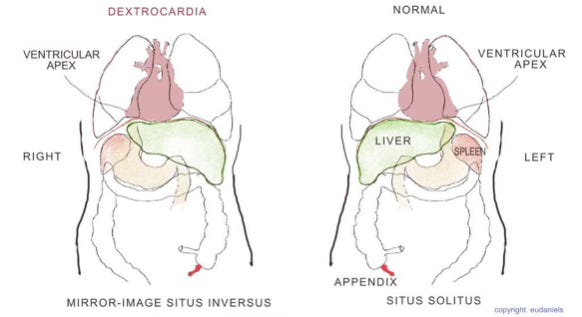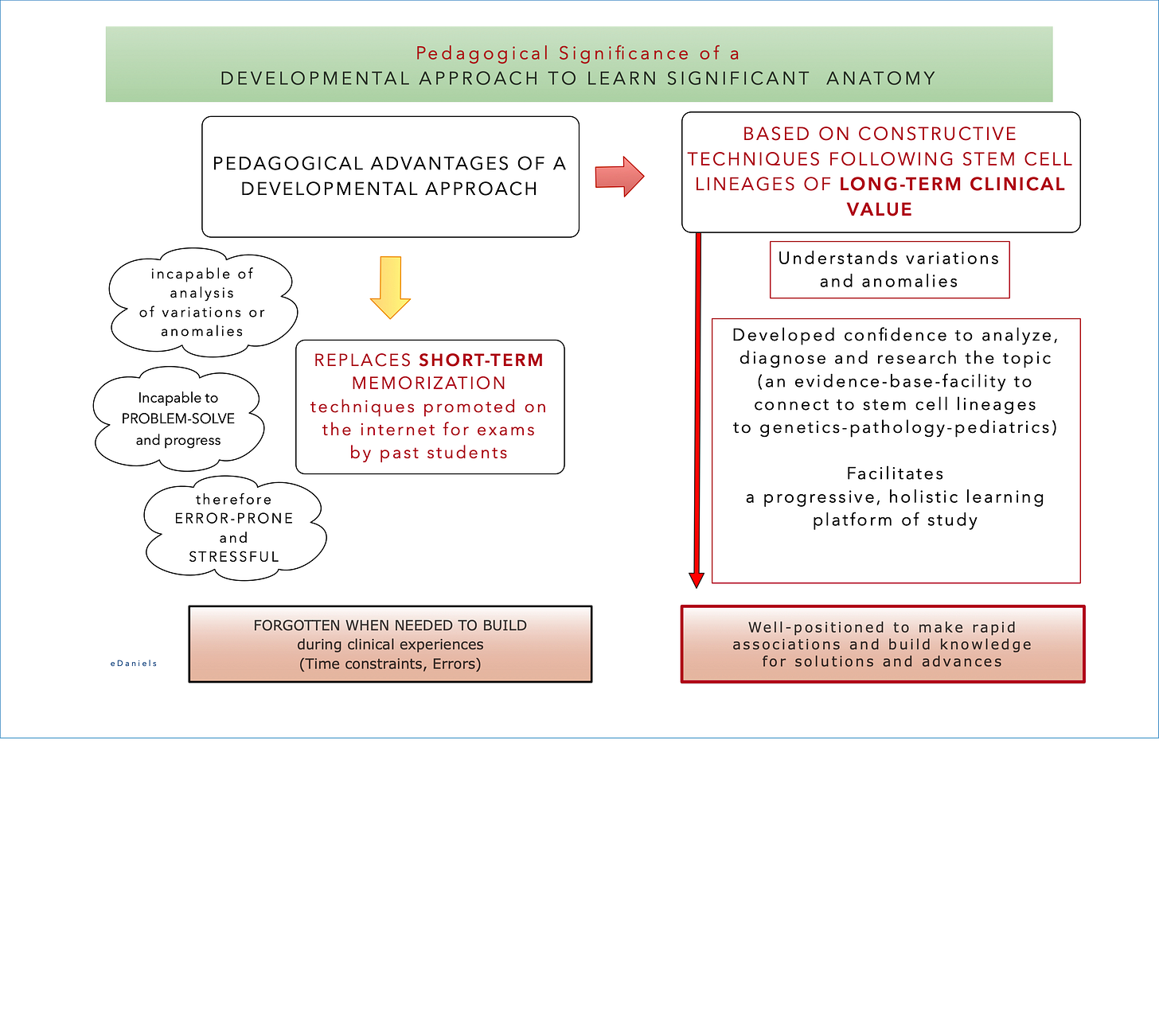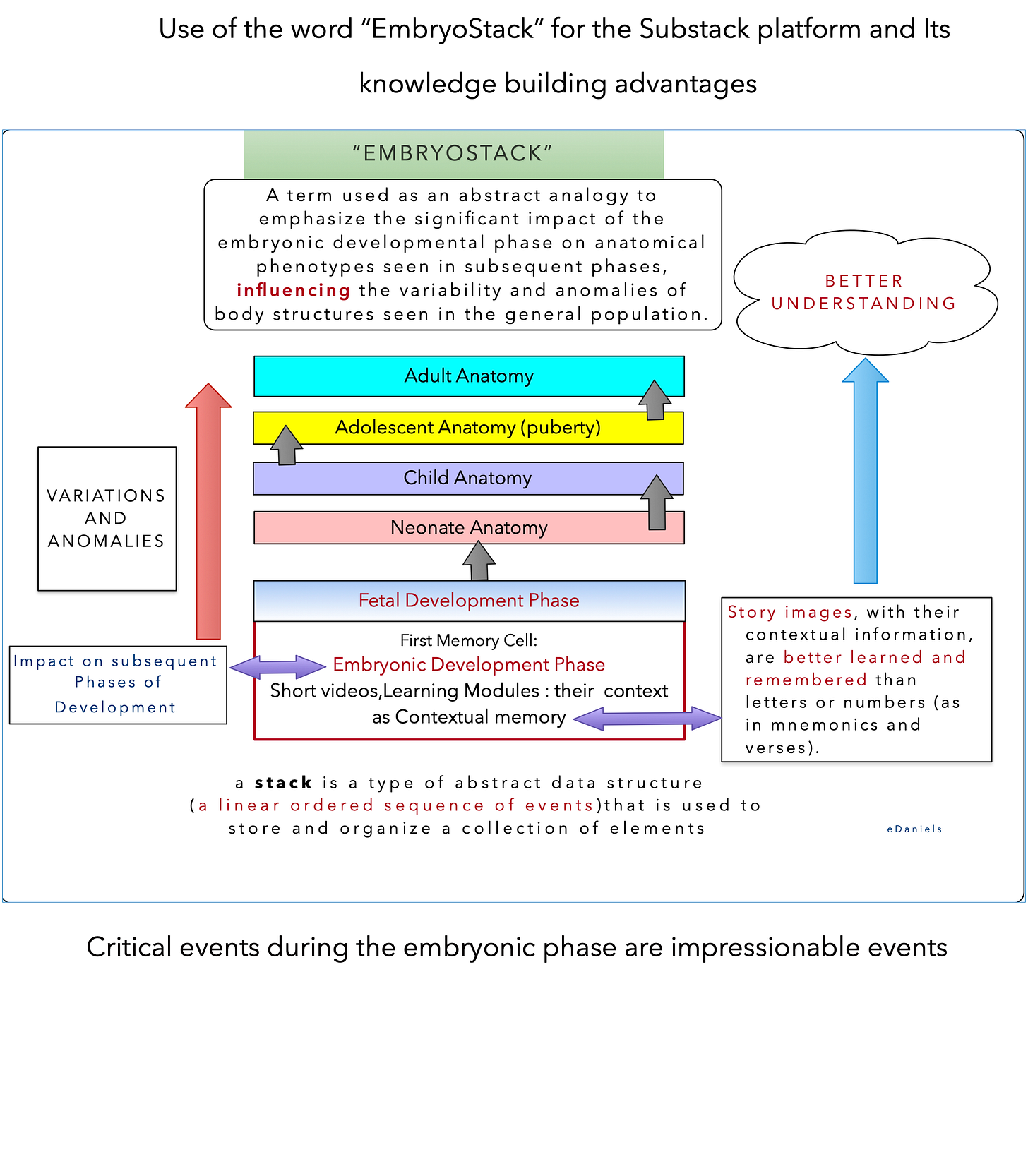Medical EmbryoStack
Embryology-Anatomy competency in modern medical curricula. The impact of embryonic patterning on interpreting human anatomical variations.
.
This forum is designed to help beginner students in modern medical programs with self-paced independent learning of a core subject. It provides answers to questions about human embryonic development (including stem cell lineages ) and introduces a discussion board (threads) for engagement with your peers.
Starting in July 2024, a newsletter dedicated to building knowledge on Embryology-Anatomy for medical and dental students will be regularly published. Three newsletters per month will be published initially, and the number will adapt to student needs.
Title: Human Embryology Forum For Medical Students
About EmbryoStack: Human Embryology, the study of the earliest developmental formative events of the human body, is a complex and time-consuming core medical subject. We understand the challenges it poses in modern, time-challenged medical curricula. That is why our platform offers an adaptive pedagogical approach tailored to long-term knowledge building for beginners. This forum answers your questions on human embryonic development, a crucial phase of the body's developmental anatomy. A widespread trend in new medical curricula is that the teaching of embryology is primarily incorporated with anatomy courses (81%), with a clinical need for embryology and anatomy teaching to be expanded into the second year and beyond (Smith et al. 2021). The forum discusses stem cell lineage concepts and significant formative events that pattern the body. This approach aims to enhance your understanding of the formation of body variations and stem cell lineages in a manner that is pertinent to your future medical career, preparing you to address realistic diagnostic challenges in diverse population demographics.
Promise: Our regular posts, beginning with three per month and adapting to student needs, will delve into embryonic developmental topics*, focusing on practical aspects related to understanding the complexities of the developing body, including essential knowledge for the diagnosis of variations contributing to error reduction. This platform allows you to actively engage with the material with your peers and, in doing so, refine your communication skills relevant to your profession.
*Discussion threads on important topics from the eBook "Human eEmbryology For Progressive Student Learning," which is a comprehensive study guide in preparation to meet the needs of new students in modern medical curricula.
Several factors necessitate the development of a relevant, self-paced e-learning program for embryology/developmental anatomy understanding in modern curricula.
Reduced Teaching Hours: Traditional embryonic development courses face shrinking instructional time due to evolving priorities in medical education. This condensed timeframe hinders students' thorough grounding in core developmental concepts essential to identifying and understanding body variations and contemporary stem cell therapeutic potentials.
Diverse Student Needs: Modern medical schools wisely admit students with varied academic backgrounds. However, a one-size-fits-all approach in introductory courses fails to cater to these diverse needs, creating a learning environment akin to a "one-room schoolhouse” of the past.
Superficial Learning: The pressure to memorize for exams often leads to superficial understanding and a lack of long-term retention. This becomes problematic when students need to independently apply and advance their knowledge during their careers. There is a need to focus on long-term learning rather than short-term performance.
Understanding 3-D structural Dynamics: Embryonic development and diagnostic interpretations (e.g., MRIs) heavily rely on visualizing and comprehending dynamic three-dimensional changes. This is a well-documented challenge for students, which requires early learning and familiarity inherent in embryology.
Teacher Scarcity: There's a global shortage of educators who can bridge the gap between molecular embryology, clinical anatomy, developmental variations/anomalies, and the potential of stem cell therapies.
The 2021 COVID-19 pandemic highlighted the universal need for independent online learning as part of hybrid learning models.
Case Study: In the first year of medical school, students often face a significant challenge studying human anatomy, especially if they come from different backgrounds and have varying levels of preparation. To pass compulsory anatomy exams, they tend to rely heavily on short-term memorization techniques, particularly when traditional supportive core courses, such as early embryonic patterning, are reduced or removed from the time-restrictive curriculum. Addressing this curriculum gap involves implementing progressive solutions that encourage self-evaluation, reflection, and the effective use of Artificial Intelligence (AI) alongside their earlier core learning. However, effective use of AI requires an earlier learning experience. (see EmbryoStack figure and advantage of contextual memory). This approach enables students to achieve competence, allowing them to devote more time to personalized patient care.
[The significance of ensuring time for undivided attention to enable personalized communication and care has been addressed for clinical scenarios in the progressive substack presentation by Christian Farr and Rohan Ramakrishna. Second Opinion: Storytelling should be a core part of the curriculum on 23 April 2024. post ref. ]
The authors discuss the curricular need for undivided attention for relevant patient communication as well as the appropriate use of available Artificial Intelligence (AI) as an information aid and time facilitator.]
The Need for a Structured Learning Experience
Novice health science students need explicit guidance on curriculum goals and expectations for independent continual learning. A formal pedagogical approach with specific instruction and guidance is often neglected in a changing curriculum where traditional courses are reduced or removed, e.g., the significance of embryology teaching. In studying the human body, a clear explanation of the early embryonic phase is crucial to understanding the impact of embryonic development on subsequent developmental phases, as well as the genetic effects it has on growth patterns, variations, anomalies, and anatomical syndromes. Without a proper understanding of this phase, it is not surprising that many students refer to online suggestions by past students on "how best to memorize anatomy" as a short-term solution.
Student reliance on online advice and memorization techniques can lead to understanding deficits and can be detrimental. Instead, intellectually curious students require realistic pedagogical information steps to succeed in long-term understanding and effective clinical progression. During the study of the embryonic phase, the inclusion of embryonic-anatomical correlates and learning modules provides an immediate, practical, holistic understanding of the developing body during the initial year(s) of anatomy study.
New Artificial Intelligence (AI) technologies, such as Microsoft CoPilate and Google Gemini or ChatGPT, can recall intricate structural information whenever needed. However, teaching a competent physician still requires early familiarity and learnt abilities for specific verification, problem-solving potential, and determining individual contexts, not reliance on memorized information without a developmental context.
A Curricular Assist: Self-paced Knowledge Building Approach
Our e-learning platform utilizes an early Knowledge Building (KB) approach, which promotes self-paced foundational learning from the embryonic phase of development. Effective teaching of embryology and anatomy is crucial to ensure that students are well-equipped to identify body variations essential for accurate diagnosis and treatment of patients. A comprehensive anatomy study conducted by Kommerley et al. (2024) highlights this teaching need and suggests that anatomy curricula failing to address body variations present in the general population are inherently inadequate and may lead to outcome deficiencies.
The early knowledge-building concept also fosters confidence and independent learning throughout their careers. This aligns with the principles of true Knowledge-Building as defined by Scardamalia and Bereiter (2006), ultimately preparing students for greater accuracy in the clinical setting and a more reliable potential for effective improvements in the healthcare system ( see below: Pedagogical Significance of a Developmental approach to learn Significiqant Anatomy)
Embryology (the study of embryos) and Developmental Anatomy (anatomy at different developmental phases) need clarifications in terminology.
Developmental anatomy involves a phasic study approach that focuses on the structural changes that occur in an organism from fertilization to adulthood. This includes the earliest formation of cells, tissues, and organs that make up all the body's systems. The initial phase, the embryonic developmental phase, begins at fertilization to form a genetically unique cell (the zygote) that actively generates the tissues, primordial organs, and systems within the approximated first 60 days.
This complex and vulnerable phase determines how all subsequent phases (fetal and postnatal phases ) will progress. These phases may be normal, with variations, or abnormal, causing defects seen at birth (congenitally) or appearing during subsequent postnatal phases. Hence, the embryonic developmental phase is essential to provide a foundation for intelligent novice students to study anatomy as the body develops. In addition, it provides a fundamental understanding of stem cell lineages and their therapies, diagnostic awareness, fertility interventions, and new understandings of pathologies (e.g., ciliopathies).
Note that the so-called “Embryology textbooks” typically cover all prenatal phases, including the continuous transitions from the embryonic to fetal phases.
The 'EmbryoStack Forum For Medical Students' is more than just a name; it's a space where you can explore eBook embryology topics in-depth, ask questions, and interact with your peers. This idea of an embryonic generative process that fosters a better understanding of primary causes and effects in later developmental phases is summarized below:
REFERENCES:
Kimmorley A L, M S Mikaela and L Gregory (23 April 2024) Anatomical variation is the norm: A novel curriculum framework. Anat Sc Education (online version before inclusion in the journal) https://doi.org/10.1002/ase.2428
Scardamalia, M., & Bereiter, C. (2006). Knowledge Building: Theory, Pedagogy, and Technology. In R. K. Sawyer (Ed.), The Cambridge handbook of: The learning sciences (pp. 97–115). Cambridge University Press.
Smith C F, Samuel K. Freeman, David Heylings, Gabrielle M. Finn, D. Ceri Davies
(2021) Anatomy education for medical students in the United Kingdom and Republic of Ireland in 2019: A 20-year follow-up. Anatomical Sciences Education 15:6,993-1006
About the author's teaching philosophy in modern medical curricula:
The author completed a doctoral degree in Embryology under the supervision of Professor Keith L Moore, a world-renowned author of medical Embryology and Anatomy textbooks. The author was inspired by Professor Moore's successful implementation of a "developmental approach to teaching anatomy," which guided his teaching and earned him several medical teaching awards at McGill University. The awards include the Osler Award for Outstanding Teaching, the Royal Bank Teaching Innovation Award, and The Federation of Quebec Medical Student's Societies Lecturer Award. He was also selected for inclusion in the Academic Keys Who's Who in Medical Science Education (WWMSE) and the Canadian Association of Medical Education Certificate of Merit.
Inspiration from research experiences: My contributions to research-based embryology courses at the McGill Goodman Cancer Centre for graduate students (Molecular Embryology) and the coordination and teaching of an advanced research-based course (Development, Disease, and Regeneration) with ten McGill Cancer researchers are testaments to my belief in the relevance and power of research-based teaching and learning.
The author has published developmental and molecular embryology studies in relevant peer-reviewed developmental journals, including Development, Gene Expression Patterns, Developmental Dynamics, Mechanisms of Development, Biol. of Neonatology, Plos One, Teratology, Exp Hemat, Cancer Res, and other cell biology journals. The author's research experiences influenced his scientific-based concept of the eBook, which incorporates stem cell lineage studies and current evidence-based interpretations of mechanisms in normal and abnormal development at all phases.
A New Post Coming Soon:
Title: “Why is the embryonic developmental phase patterned to form variations, and is the most vulnerable phase to form anomalies?”




